2019 Hyundai Ioniq Electric seats
[x] Cancel search: seatsPage 189 of 555
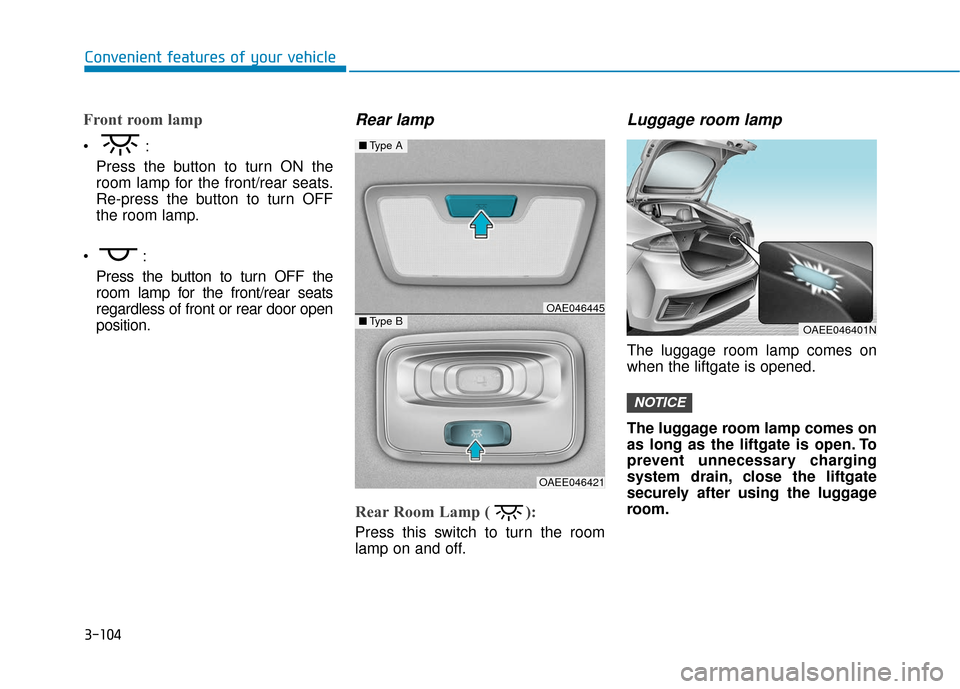
3-104
Convenient features of your vehicle
Front room lamp
Press the button to turn ON the
room lamp for the front/rear seats.
Re-press the button to turn OFF
the room lamp.
Press the button to turn OFF the
room lamp for the front/rear seats
regardless of front or rear door open
position.
Rear lamp
Rear Room Lamp ( ):
Press this switch to turn the room
lamp on and off.
Luggage room lamp
The luggage room lamp comes on
when the liftgate is opened.
The luggage room lamp comes on
as long as the liftgate is open. To
prevent unnecessary charging
system drain, close the liftgate
securely after using the luggage
room.
NOTICE
■ Type A
■Type BOAE046445
OAEE046421
OAEE046401N
Page 373 of 555
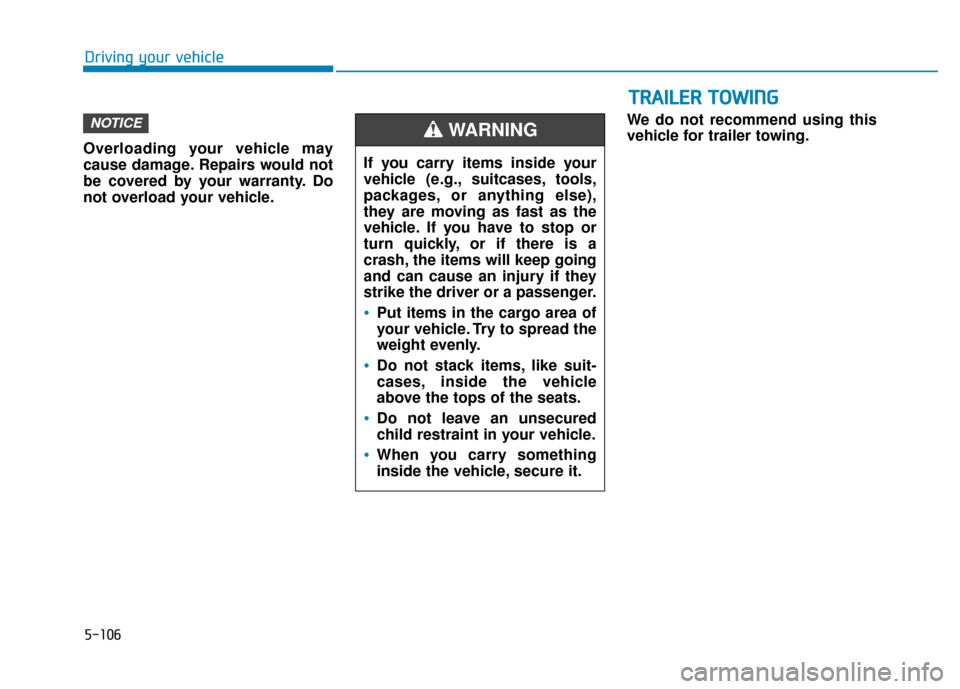
5-106
Driving your vehicle
Overloading your vehicle may
cause damage. Repairs would not
be covered by your warranty. Do
not overload your vehicle. We do not recommend using this
vehicle for trailer towing.
NOTICE
T T
R
R A
A I
IL
L E
E R
R
T
T O
O W
W I
IN
N G
G
If you carry items inside your
vehicle (e.g., suitcases, tools,
packages, or anything else),
they are moving as fast as the
vehicle. If you have to stop or
turn quickly, or if there is a
crash, the items will keep going
and can cause an injury if they
strike the driver or a passenger.
Put items in the cargo area of
your vehicle. Try to spread the
weight evenly.
Do not stack items, like suit-
cases, inside the vehicle
above the tops of the seats.
Do not leave an unsecured
child restraint in your vehicle.
When you carry something
inside the vehicle, secure it.
WARNING
Page 432 of 555
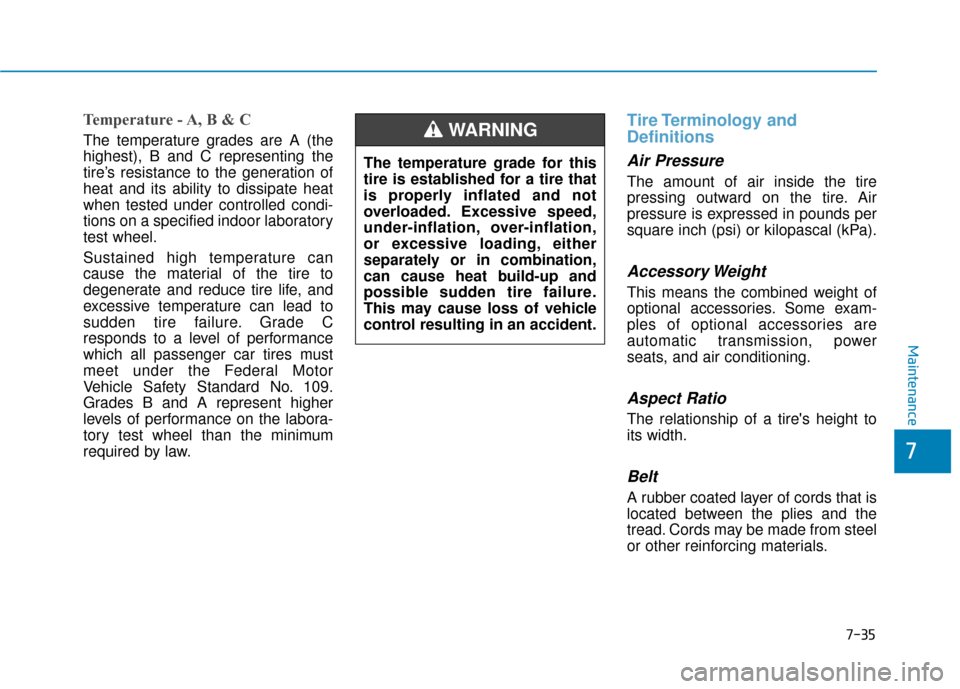
7-35
7
Maintenance
Temperature - A, B & C
The temperature grades are A (the
highest), B and C representing the
tire’s resistance to the generation of
heat and its ability to dissipate heat
when tested under controlled condi-
tions on a specified indoor laboratory
test wheel.
Sustained high temperature can
cause the material of the tire to
degenerate and reduce tire life, and
excessive temperature can lead to
sudden tire failure. Grade C
responds to a level of performance
which all passenger car tires must
meet under the Federal Motor
Vehicle Safety Standard No. 109.
Grades B and A represent higher
levels of performance on the labora-
tory test wheel than the minimum
required by law.
Tire Terminology and
Definitions
Air Pressure
The amount of air inside the tire
pressing outward on the tire. Air
pressure is expressed in pounds per
square inch (psi) or kilopascal (kPa).
Accessory Weight
This means the combined weight of
optional accessories. Some exam-
ples of optional accessories are
automatic transmission, power
seats, and air conditioning.
Aspect Ratio
The relationship of a tire's height to
its width.
Belt
A rubber coated layer of cords that is
located between the plies and the
tread. Cords may be made from steel
or other reinforcing materials.
The temperature grade for this
tire is established for a tire that
is properly inflated and not
overloaded. Excessive speed,
under-inflation, over-inflation,
or excessive loading, either
separately or in combination,
can cause heat build-up and
possible sudden tire failure.
This may cause loss of vehicle
control resulting in an accident.
WARNING
Page 467 of 555
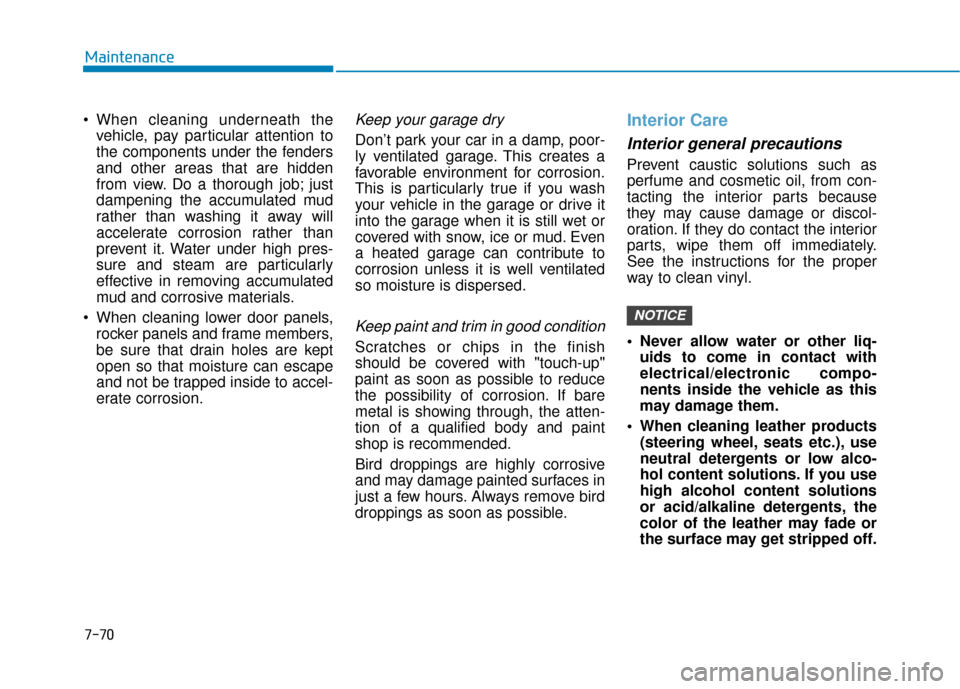
7-70
Maintenance
vehicle, pay particular attention to
the components under the fenders
and other areas that are hidden
from view. Do a thorough job; just
dampening the accumulated mud
rather than washing it away will
accelerate corrosion rather than
prevent it. Water under high pres-
sure and steam are particularly
effective in removing accumulated
mud and corrosive materials.
When cleaning lower door panels, rocker panels and frame members,
be sure that drain holes are kept
open so that moisture can escape
and not be trapped inside to accel-
erate corrosion.
Keep your garage dry
Don’t park your car in a damp, poor-
ly ventilated garage. This creates a
favorable environment for corrosion.
This is particularly true if you wash
your vehicle in the garage or drive it
into the garage when it is still wet or
covered with snow, ice or mud. Even
a heated garage can contribute to
corrosion unless it is well ventilated
so moisture is dispersed.
Keep paint and trim in good condition
Scratches or chips in the finish
should be covered with "touch-up"
paint as soon as possible to reduce
the possibility of corrosion. If bare
metal is showing through, the atten-
tion of a qualified body and paint
shop is recommended.
Bird droppings are highly corrosive
and may damage painted surfaces in
just a few hours. Always remove bird
droppings as soon as possible.
Interior Care
Interior general precautions
Prevent caustic solutions such as
perfume and cosmetic oil, from con-
tacting the interior parts because
they may cause damage or discol-
oration. If they do contact the interior
parts, wipe them off immediately.
See the instructions for the proper
way to clean vinyl.
Never allow water or other liq-uids to come in contact with
electrical/electronic compo-
nents inside the vehicle as this
may damage them.
When cleaning leather products (steering wheel, seats etc.), use
neutral detergents or low alco-
hol content solutions. If you use
high alcohol content solutions
or acid/alkaline detergents, the
color of the leather may fade or
the surface may get stripped off.
NOTICE
Page 469 of 555
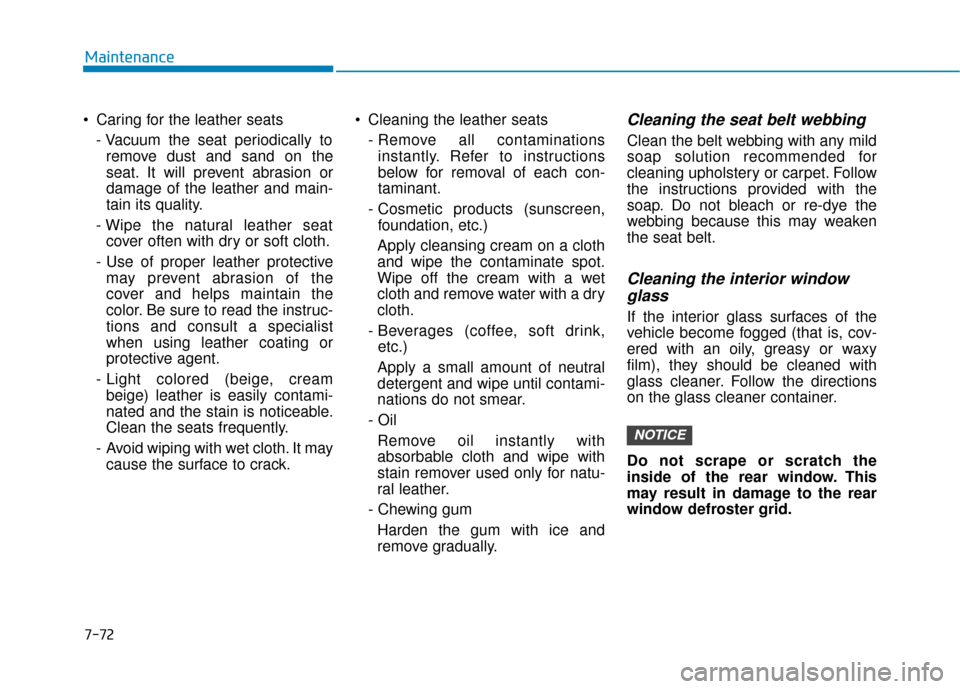
7-72
Maintenance
Caring for the leather seats - Vacuum the seat periodically toremove dust and sand on the
seat. It will prevent abrasion or
damage of the leather and main-
tain its quality.
- Wipe the natural leather seat cover often with dry or soft cloth.
- Use of proper leather protective may prevent abrasion of the
cover and helps maintain the
color. Be sure to read the instruc-
tions and consult a specialist
when using leather coating or
protective agent.
- Light colored (beige, cream beige) leather is easily contami-
nated and the stain is noticeable.
Clean the seats frequently.
- Avoid wiping with wet cloth. It may cause the surface to crack. Cleaning the leather seats
- Remove all contaminationsinstantly. Refer to instructions
below for removal of each con-
taminant.
- Cosmetic products (sunscreen, foundation, etc.)
Apply cleansing cream on a cloth
and wipe the contaminate spot.
Wipe off the cream with a wet
cloth and remove water with a dry
cloth.
- Beverages (coffee, soft drink, etc.)
Apply a small amount of neutral
detergent and wipe until contami-
nations do not smear.
- Oil Remove oil instantly with
absorbable cloth and wipe with
stain remover used only for natu-
ral leather.
- Chewing gum Harden the gum with ice and
remove gradually.
Cleaning the seat belt webbing
Clean the belt webbing with any mild
soap solution recommended for
cleaning upholstery or carpet. Follow
the instructions provided with the
soap. Do not bleach or re-dye the
webbing because this may weaken
the seat belt.
Cleaning the interior windowglass
If the interior glass surfaces of the
vehicle become fogged (that is, cov-
ered with an oily, greasy or waxy
film), they should be cleaned with
glass cleaner. Follow the directions
on the glass cleaner container.
Do not scrape or scratch the
inside of the rear window. This
may result in damage to the rear
window defroster grid.
NOTICE
Page 540 of 555
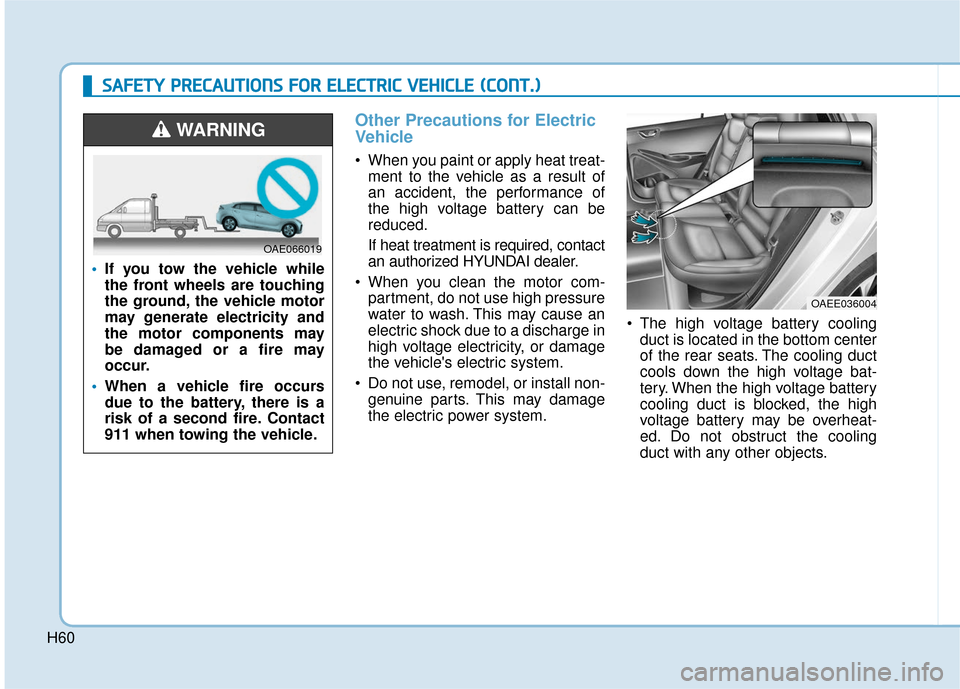
H60
Other Precautions for Electric
Vehicle
When you paint or apply heat treat-ment to the vehicle as a result of
an accident, the performance of
the high voltage battery can be
reduced.
If heat treatment is required, contact
an authorized HYUNDAI dealer.
When you clean the motor com- partment, do not use high pressure
water to wash. This may cause an
electric shock due to a discharge in
high voltage electricity, or damage
the vehicle's electric system.
Do not use, remodel, or install non- genuine parts. This may damage
the electric power system. The high voltage battery cooling
duct is located in the bottom center
of the rear seats. The cooling duct
cools down the high voltage bat-
tery. When the high voltage battery
cooling duct is blocked, the high
voltage battery may be overheat-
ed. Do not obstruct the cooling
duct with any other objects.
If you tow the vehicle while
the front wheels are touching
the ground, the vehicle motor
may generate electricity and
the motor components may
be damaged or a fire may
occur.
When a vehicle fire occurs
due to the battery, there is a
risk of a second fire. Contact
911 when towing the vehicle.
WARNING
OAE066019
OAEE036004
S
SA
A F
FE
E T
T Y
Y
P
P R
R E
EC
CA
A U
U T
TI
IO
O N
NS
S
F
F O
O R
R
E
E L
LE
E C
CT
T R
R I
IC
C
V
V E
EH
H I
IC
C L
LE
E
(
( C
C O
O N
NT
T.
.)
)
Page 545 of 555
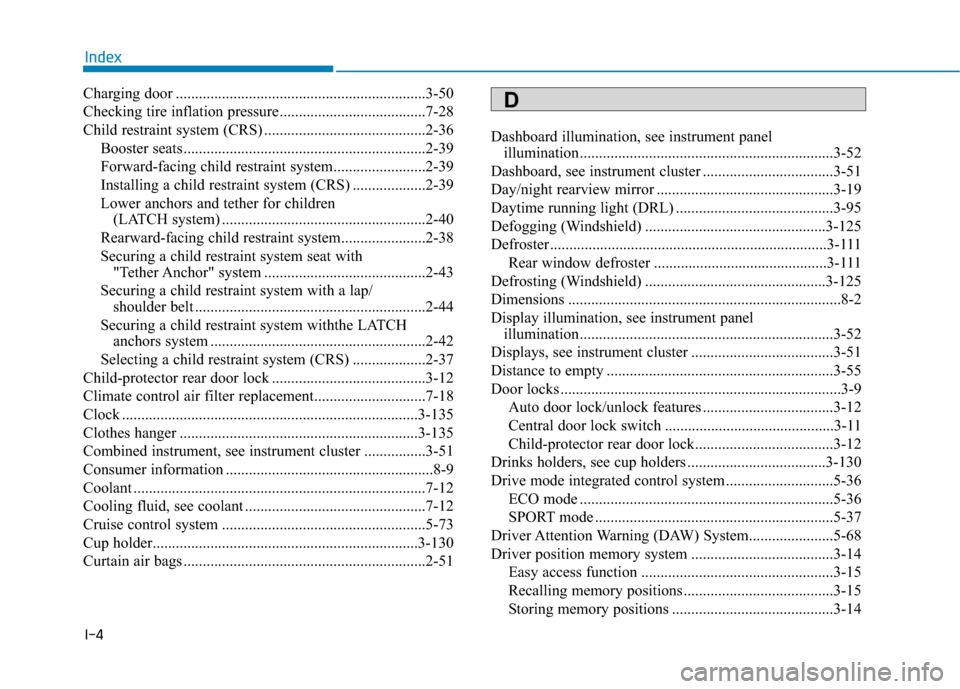
I-4
Charging door .................................................................3-50
Checking tire inflation pressure ......................................7-28
Child restraint system (CRS) ..........................................2-36Booster seats...............................................................2-39
Forward-facing child restraint system........................2-39
Installing a child restraint system (CRS) ...................2-39
Lower anchors and tether for children (LATCH system) .....................................................2-40
Rearward-facing child restraint system......................2-38
Securing a child restraint system seat with "Tether Anchor" system ..........................................2-43
Securing a child restraint system with a lap/ shoulder belt ............................................................2-44
Securing a child restraint system withthe LATCH anchors system ........................................................2-42
Selecting a child restraint system (CRS) ...................2-37
Child-protector rear door lock ........................................3-12
Climate control air filter replacement.............................7-18
Clock ........................................................................\
.....3-135
Clothes hanger ..............................................................3-135
Combined instrument, see instrument cluster ................3-51
Consumer information ......................................................8-9
Coolant ........................................................................\
....7-12
Cooling fluid, see coolant ...............................................7-12
Cruise control system .....................................................5-73
Cup holder.....................................................................3-1\
30
Curtain air bags ...............................................................2-51 Dashboard illumination, see instrument panel
illumination..................................................................3-52
Dashboard, see instrument cluster ..................................3-51
Day/night rearview mirror ..............................................3-19
Daytime running light (DRL) .........................................3-95
Defogging (Windshield) ...............................................3-125
Defroster ........................................................................\
3-111 Rear window defroster .............................................3-111
Defrosting (Windshield) ...............................................3-125
Dimensions .......................................................................8\
-2
Display illumination, see instrument panel illumination..................................................................3-52
Displays, see instrument cluster .....................................3-51
Distance to empty ...........................................................3-55
Door locks ........................................................................\
.3-9 Auto door lock/unlock features ..................................3-12
Central door lock switch ............................................3-11
Child-protector rear door lock....................................3-12
Drinks holders, see cup holders ....................................3-130
Drive mode integrated control system ............................5-36 ECO mode ..................................................................5-36
SPORT mode ..............................................................5-37
Driver Attention Warning (DAW) System......................5-68
Driver position memory system .....................................3-14 Easy access function ..................................................3-15
Recalling memory positions .......................................3-15
Storing memory positions ..........................................3-14
Index
D
Page 552 of 555
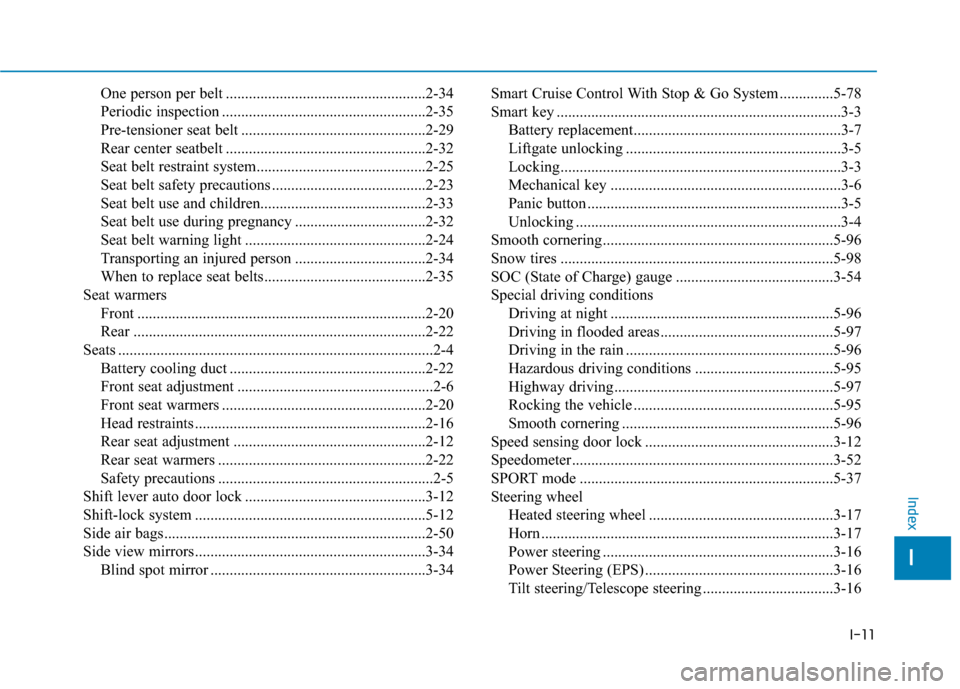
I-11
One person per belt ....................................................2-34
Periodic inspection .....................................................2-35
Pre-tensioner seat belt ................................................2-29
Rear center seatbelt ....................................................2-32
Seat belt restraint system............................................2-25
Seat belt safety precautions ........................................2-23
Seat belt use and children...........................................2-3\
3
Seat belt use during pregnancy ..................................2-32
Seat belt warning light ...............................................2-24
Transporting an injured person ..................................2-34
When to replace seat belts..........................................2-35
Seat warmers Front ........................................................................\
...2-20
Rear ........................................................................\
....2-22
Seats ........................................................................\
..........2-4 Battery cooling duct ...................................................2-22
Front seat adjustment ...................................................2-6
Front seat warmers .....................................................2-20
Head restraints ............................................................2-16
Rear seat adjustment ..................................................2-12
Rear seat warmers ......................................................2-22
Safety precautions ........................................................2-5
Shift lever auto door lock ...............................................3-12
Shift-lock system ............................................................5-12
Side air bags....................................................................2-50\
Side view mirrors............................................................3-34 Blind spot mirror ........................................................3-34 Smart Cruise Control With Stop & Go System ..............5-78
Smart key ........................................................................\
..3-3
Battery replacement......................................................3-7
Liftgate unlocking ........................................................3-5
Locking........................................................................\
.3-3
Mechanical key ............................................................3-6
Panic button ..................................................................3-5
Unlocking .....................................................................3-4\
Smooth cornering............................................................5-96
Snow tires .......................................................................5\
-98
SOC (State of Charge) gauge .........................................3-54
Special driving conditions Driving at night ..........................................................5-96
Driving in flooded areas .............................................5-97
Driving in the rain ......................................................5-96
Hazardous driving conditions ....................................5-95
Highway driving.........................................................5-97
Rocking the vehicle ....................................................5-95
Smooth cornering .......................................................5-96
Speed sensing door lock .................................................3-12
Speedometer....................................................................3-52\
SPORT mode ..................................................................5-37
Steering wheel Heated steering wheel ................................................3-17
Horn ........................................................................\
....3-17
Power steering ............................................................3-16
Power Steering (EPS) .................................................3-16
Tilt steering/Telescope steering ..................................3-16
I
Index